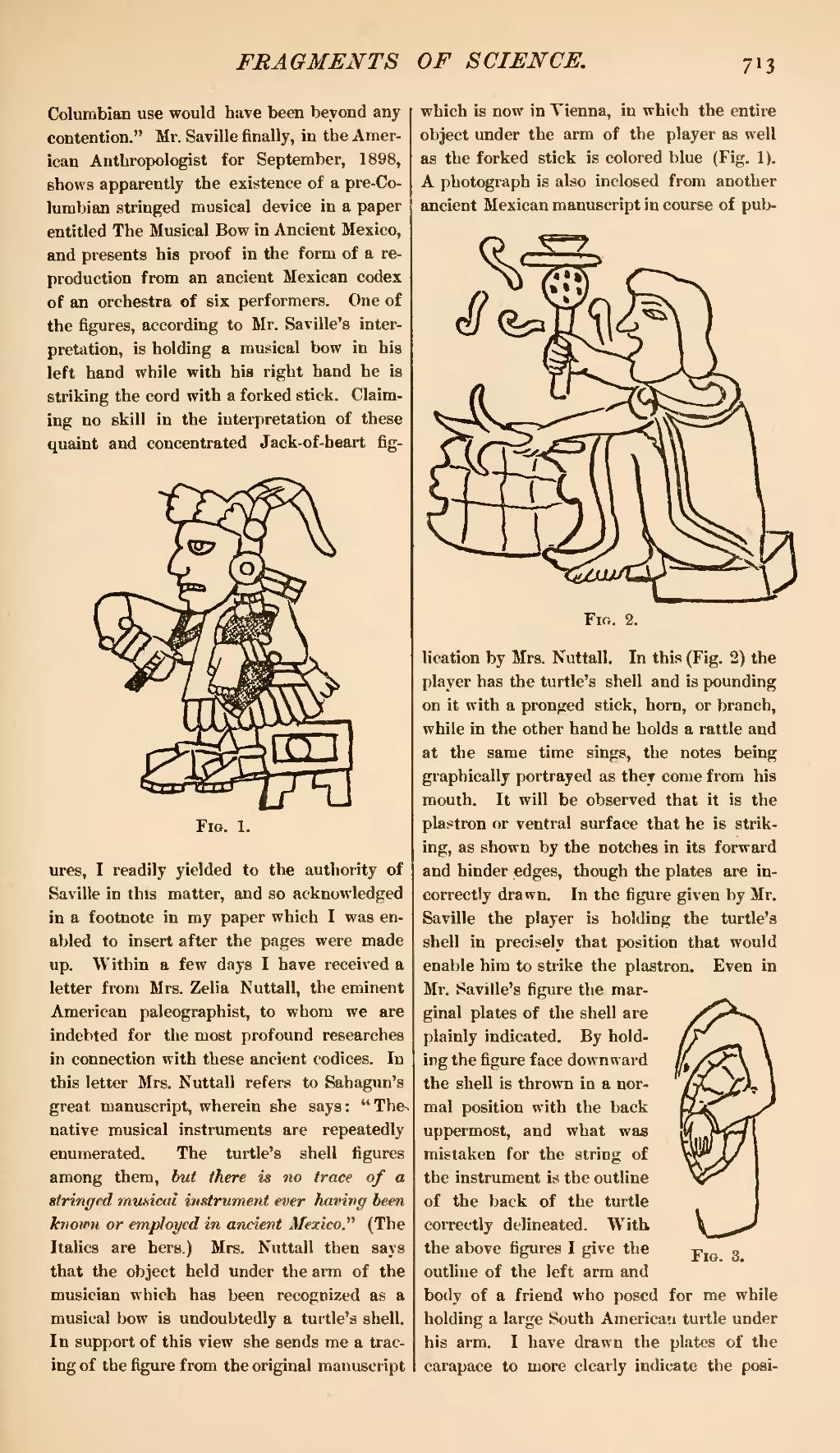Columbian use would have been beyond any contention." Mr. Saville finally, in the American Anthropologist for September, 1898, shows apparently the existence of a pre-Columbian stringed musical device in a paper entitled The Musical Bow in Ancient Mexico, and presents his proof in the form of a reproduction from an ancient Mexican codex of an orchestra of six performers.

Fig. 1.
One of the figures, according to Mr. Saville's interpretation, is holding a musical bow in his left hand while with his right hand he is striking the cord with a forked stick. Claiming no skill in the interpretation of these quaint and concentrated Jack-of-heart figures, I readily yielded to the authority of Saville in this matter, and so acknowledged in a footnote in my paper which I was enabled to insert after the pages were made up. Within a few days I have received a letter from Mrs. Zelia Nuttall, the eminent American paleographist, to whom we are indebted for the most profound researches in connection with these ancient codices. In this letter Mrs. Nuttall refers to Sahagun's great manuscript, wherein she says: "The native musical instruments are repeatedly enumerated. The turtle's shell figures among them, but there is no trace of a stringed musical instrument ever having been known or employed in ancient Mexico. (The Italics are hers.) Mrs. Nuttall then says that the object held under the arm of the musician which has been recognized as a musical bow is undoubtedly a turtle's shell.

Fig. 2.
In support of this view she sends me a tracing of the figure from the original manuscript which is now in Vienna, in which the entire object under the arm of the player as well as the forked stick is colored blue (Fig. 1). A photograph is also inclosed from another ancient Mexican manuscript in course of publication by Mrs. Nuttall. In this (Fig. 2) the player has the turtle's shell and is pounding on it with a pronged stick,  Fig. 3. horn, or branch, while in the other hand he holds a rattle and at the same time sings, the notes being graphically portrayed as they come from his mouth. It will be observed that it is the plastron or ventral surface that he is striking, as shown by the notches in its forward and hinder edges, though the plates are incorrectly drawn. In the figure given by Mr. Saville the player is holding the turtle's shell in precisely that position that would enable him to strike the plastron. Even in Mr. Saville's figure the marginal plates of the shell are plainly indicated. By holding the figure face downward the shell is thrown in a normal position with the back uppermost, and what was mistaken for the string of the instrument is the outline of the back of the turtle correctly delineated. With the above figures I give the outline of the left arm and body of a friend who posed for me while holding a large South American turtle under his arm. I have drawn the plates of the carapace to more clearly indicate the posi-
Fig. 3. horn, or branch, while in the other hand he holds a rattle and at the same time sings, the notes being graphically portrayed as they come from his mouth. It will be observed that it is the plastron or ventral surface that he is striking, as shown by the notches in its forward and hinder edges, though the plates are incorrectly drawn. In the figure given by Mr. Saville the player is holding the turtle's shell in precisely that position that would enable him to strike the plastron. Even in Mr. Saville's figure the marginal plates of the shell are plainly indicated. By holding the figure face downward the shell is thrown in a normal position with the back uppermost, and what was mistaken for the string of the instrument is the outline of the back of the turtle correctly delineated. With the above figures I give the outline of the left arm and body of a friend who posed for me while holding a large South American turtle under his arm. I have drawn the plates of the carapace to more clearly indicate the posi-

